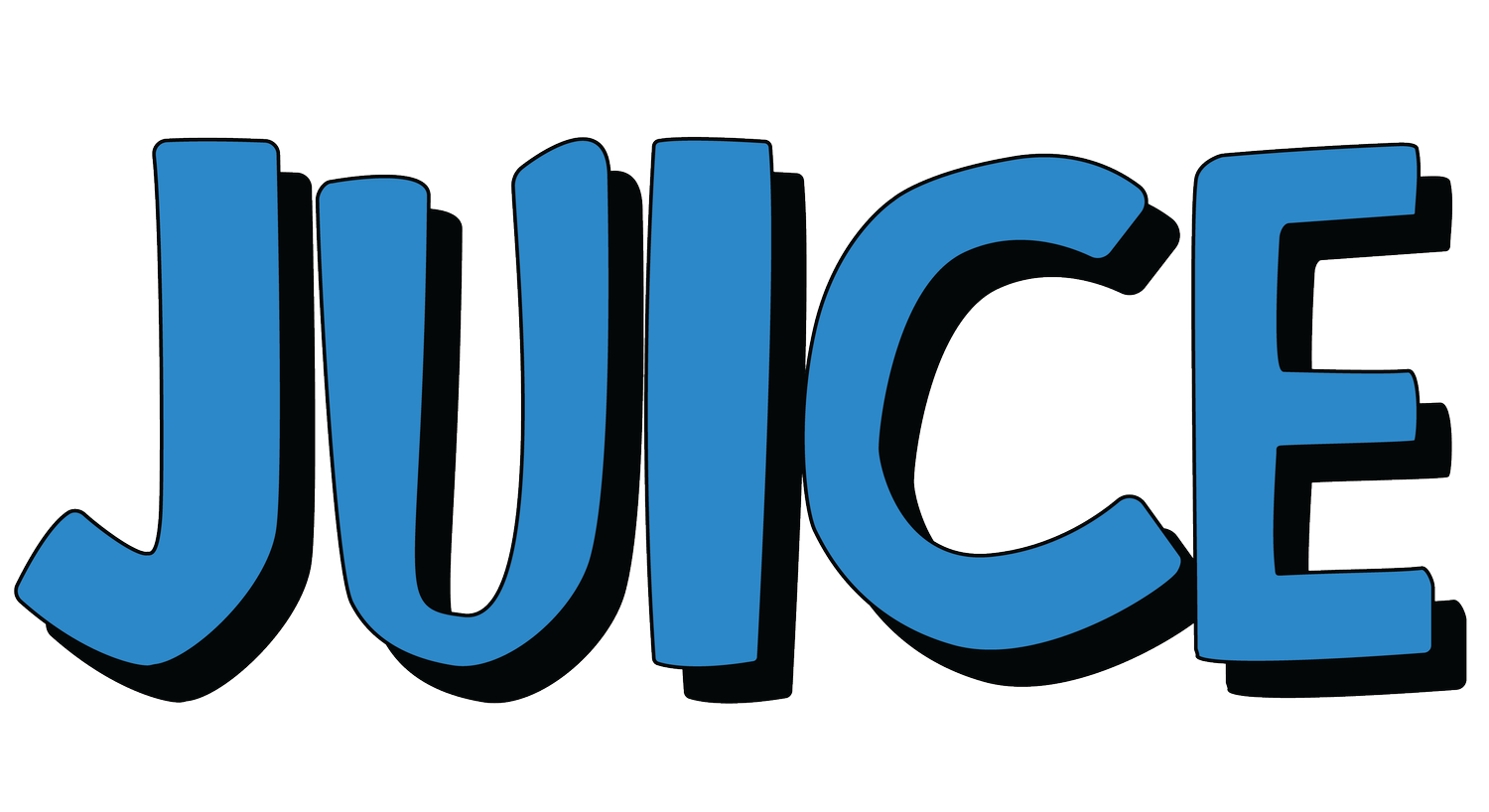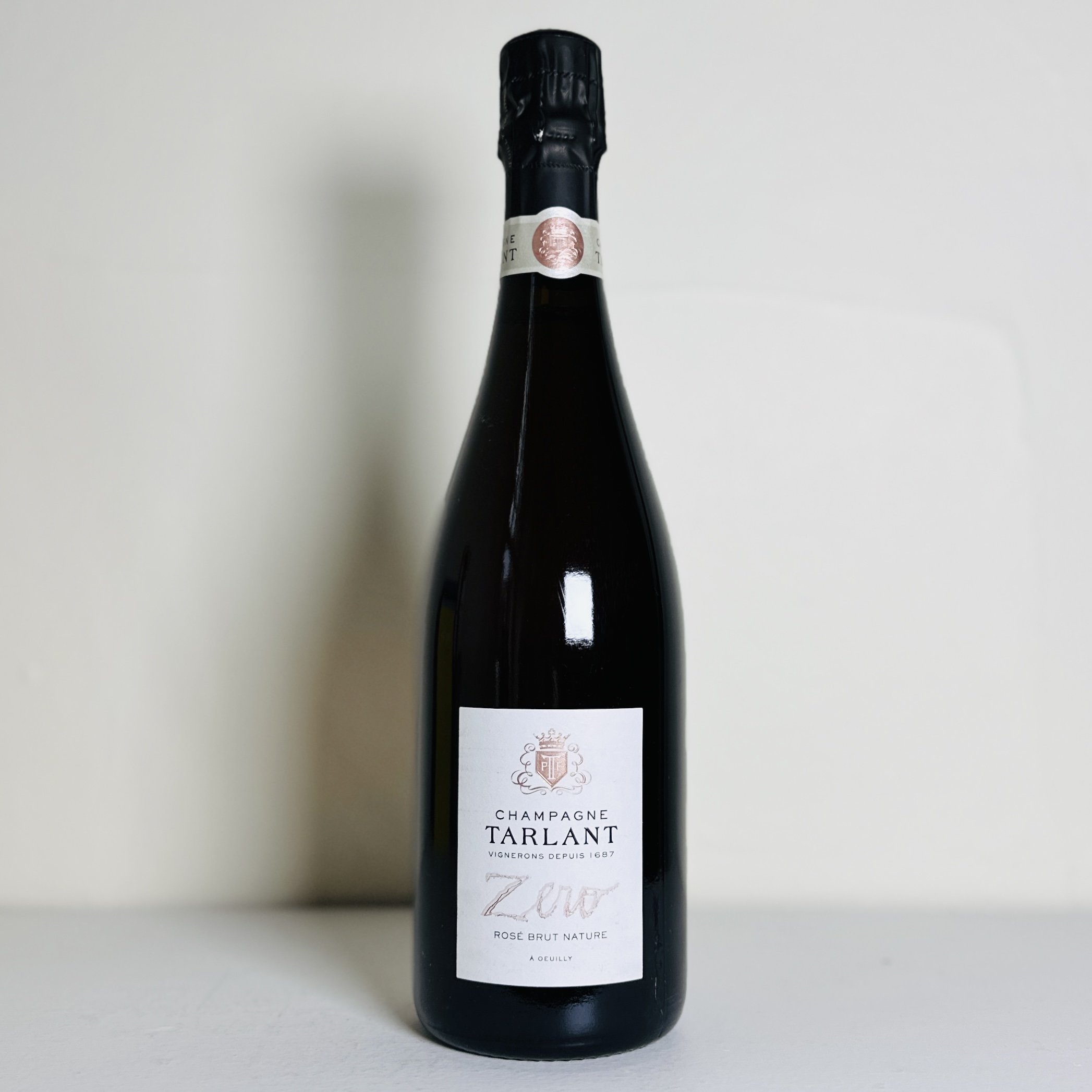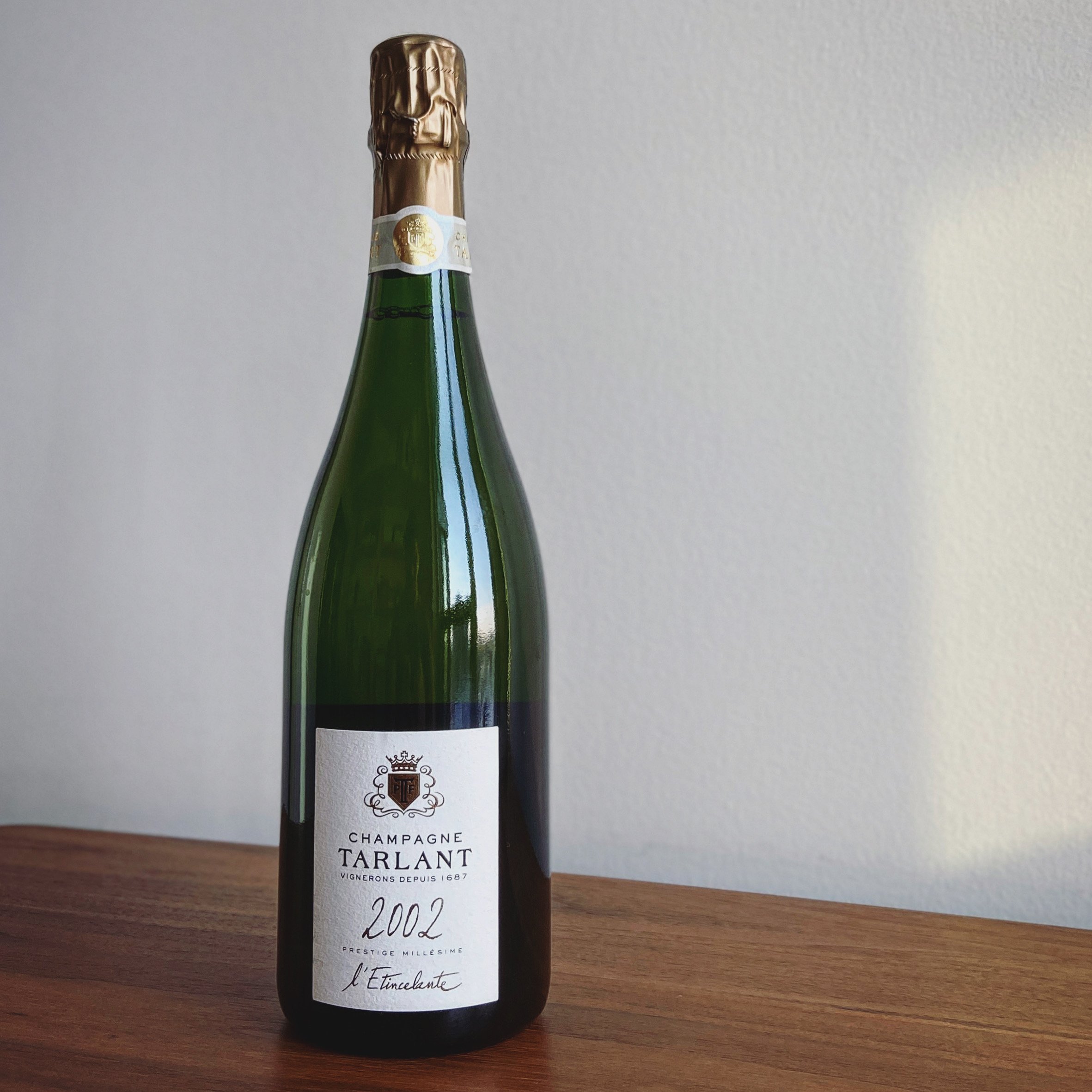CHAMPAGNE TARLANT
-
Five+ years ago, I visited Grey Gardens in Toronto for a celebratory dinner. As always, I was craving something bubbly and noticed Tarlant on the list. I’d heard rumours that their wines were sensational, so I went for it. I was immediately impressed by its complexity and depth, properly mature flavours complimented by ample freshness. It was just what I needed, another wine obsession.
I spent the next few years seeking out their wines at any opportunity, notably from Discovery Wines in New York. When the lockdowns struck in 2020, nostalgia kicked in. From isolation, fueled by solo drinking and hubris, I decided to reach out and see if my sappiness could sway them into sharing their limited production with a couple of foolhardy Canadians. Needless to say, our pleas were compelling.
-
In the spring of 2022, we set off for France to visit Champagne for the first time. Feeling a little fuzzy from the previous evening’s escapades at Reims’ legendary The Glue Pot, we drove southwest to the Marne Valley. We arrived in the town of Œuilly just in time for a pain-au-chocolate, and then we were off to the vineyards with Daniel, Melanie Tarlant’s partner. Daniel, an ex-archeologist, is incredibly bright and inviting, his wool sweater and scruff keeping him warm against the March breezes. Although the sun was warming, hinting at spring to come, the damp cold kept our bones chilled.
-
The bulk of their most exalted vineyards are located in a small amphitheatre just east of the town. The 15º slope faces north, an orientation I didn’t think was plausible in the cooler mesoclimate of the Marne Valley. They believe reflected light from the river helps them obtain ripeness, and with climate change constantly increasing temperatures, this side of the valley is getting a lot more attention.
They allow a specially selected combination of vegetable-dominant cover crops to grow between the vines, helping balance the soil. They’ll let them get to 1.5m high, encouraging the vines to grow straight and tall early in the season. They prefer these gentle forms of farming, mimicking nature to the best of their ability.
Daniel also showed us their new winter pruning ideology. Instead of cutting the vine right next to the bud, they leave a little more space. The cut is susceptible to frost and drying out, so this little buffer protects the fragile new growth. Hopefully, this will help keep the plant healthy, leading to more consistent yields and better fruit.
-
Within a few hundred meters, the soils vary drastically. The northeast-facing slope directly adjacent to Œuilly features a lieu-dit called La Pierre de Bellevue and is the inspiration for La Vigne d’Or, a Pinot Meunier Blanc de Noirs. The Sparnacian Lignite, a light brown sedimentary coal-like rock made from ancient peat, was formed roughly fifty million years ago in the Ypresian stage.
Above that, you’ll find Four A Chaux, the plot that yields Bam!, their blend of Pinot Blanc, Arbane, and Petit Meslier. These varieties, once widely planted, now represent only a tiny fraction of Champagne’s acreage. Melanie & Benoit believe they might have some resistance to climate change, retaining acidity even during warmer vintages. Yields are less predictable, so they’re constantly honing in their selection massale. The limestone and sand here were formed during the Thanetian stage 56+ million years ago. The rocky greyish limestone is an entirely different texture than the lignite, only a five-minute walk away.
Adjacent to this site, you’ll find the lieu-dit of Les Sables, named for incredibly sandy silica soils. Phylloxera can’t survive sand like this, so the Tarlants opted to plant ungrafted Chardonnay via the bent cane method – you burry a cane from an adjacent plant and when it roots well enough to sustain itself, the original cane is cut, resulting in two independent but genetically identical plants. Own-rooted vines represent less than 0.1% of the vines in Champagne, making La Vigne d’Antan one of the rarest wines in our portfolio. The soils were formed during the Lutetian Era ~45 million years ago. The era derives its name from the roman word for Paris (Lutetia), whose buildings are primarily built from limestone of the same time period.
A few hundred metres east, you’ll find the lieu-dit of Les Crayons over a slight rise. Located near the river on a 12º east-facing slope, we once again have a massive shift in soil. You’ll find pure white chalk from the Campanian Era, ~80 million years ago. Their renowned Cuvée Louis comes exclusively from this site.
-
Louis Tarlant himself is an iconic figure. The Tarlant family has been farming in this area since 1687 and moved to their current town of Œuilly in 1780. For centuries they farmed mixed crops, sold grapes, and made a little wine for personal consumption or the local pub.
At the dawn of the 20th century, it was common practice for large Champagne Houses to purchase grapes or premade wine from neighbouring regions or even other countries, blending it in with their own stocks to manipulate the flavour, but more importantly, increase their margins. This helped reinforce the notion that Champagne was a brand more than a place, something Louis, the mayor of Œuilly, took personally. Through dissenting, protest, and ultimately legislation, Louis helped establish Champagne as an Appellation d’Origine Contrôlée, codifying farming and winemaking practices. The results of these efforts are vast, economically protecting farmers and re-establishing terroir as the lynchpin of Champagne.
Louis was so disillusioned with the large Champagne houses that necessitated all this advocacy that he decided to become one of the first Recoltant Manipulant. Decades before his peers started breaking off, he established himself as an independent producer who not only grew his own grapes but made his wine as well – a surprisingly rare combination at the time, and even today, only makes up 5% of the Champagne Market.
-
The innovation didn’t stop there. Jean-Mary, Benoit & Melanie’s father, advocated for cover crops at a time when industrial farming was all the rage. His most significant contribution was a move away from cumbersome dosage levels. Historically, adding sugar after disgorging was thought of as not only desirable but necessary to make Champagne drinkable. Sweetness was often used to disguise sour flavours from underripe grapes or to hide jarring acidity. Realizing this crutch could be overcome by thoughtful farming and long élevage times, they began releasing zero dosage wines as early as the 70s, decades before the trend took off. Benoit summed this up eloquently by saying, ‘time is our dosage,’ implying long ageing on lees softens the acidity. Even reference books released within the last decade seem hesitant to advocate for this minimalist approach, but based on personal tasting experience, they seem to have it figured out.
-
In the cellar, the hand-harvested grapes are pressed into barrel for indigenous primary fermentation. Each parcel, over sixty in total, is kept separate. In the spring, they start an incredibly intense blending process. After selecting which wines will become single vineyard releases or their Zéro series, the remaining wine ends up in their reserve stocks to be used later after extended ageing.
There’s a small tunnel leading from their winery to the church in the village below. Rumour has it the locals would hide here during the war that ravaged the region. Barrels of their single vineyard wines now line this narrow space, wind rushing through at all times. It has a unique energy, cold and tense. Perhaps it imparts some of its nervousness to the wines.
-
For secondary fermentation, Benoit has an ingenious methodology to highlight terroir. Over harvest, he collects juice, fermenting wine, and finished wine from each parcel and sends it to a lab. The lab then isolates yeast strains from those plots and keeps them alive and healthy until it’s time to add the liqueur de tirage. The multi-vineyard blends will be inoculated with a blend of yeasts from those sites with the single lieu-dits fermented with single cultures. This costly and time-consuming process shows their absolute commitment to expressing terroir at all costs.
More so than any producer we’ve ever worked with, they refuse to release a wine before it’s ready. Even their entry-level wines spend 6+ years on lees before being disgorged. There’s nothing more satisfying than cracking a fully mature bottle of Champagne.
-
While tasting through their current releases, we chatted about all their side projects. They’re experimenting with a variety of amphoras for both still and sparkling wines, settling most recently on small spherical ones for Argilité. They’ve quickly gained fame for their single vineyard Coteaux Champenois made from Chardonnay, Pinot Noir, and Pinot Meunier, proving this terroir is more than capable of producing world-class still wines. They’ve also tried their hand at orange wine, macerating Chardonnay on skins for extended periods in amphora. The unreleased wine is hauntingly luminous and textural; we pray they’ll sell us a couple eventually. They’ve also started planting Pinot Gris. It is beyond today’s appellation system; however, their research indicates it may have been the first Pinot grown in the region – the pinky-copper still wines of legend, sometimes called Oeil de Perdrix, may have been skin-fermented, Pinot Gris. We even got to try their secret collaboration with Cantillon, which, despite being sworn to secrecy, has ended up in this write-up.
After our meeting, we joined Melanie and Daniel for lunch at Sacré Bistrot in Epernay, a corner bar with sensational food and a wine list packed with cult growers. We chatted for hours about life as much as wine. It’s impossible to describe how much I admire their dedication and poise. Melanie has become a mentor to many women in Champagne for her business prowess and authenticity. Benoit is a gracious intellectual, as cerebral as she is soulful and relentlessly hardworking. I can’t help but feel a sense of pride when I share their wines; how lucky we are.
MORE FROM CHAMPAGNE: CHRISTOPHE MIGNON | CHARLES DUFOUR
ZÉRO (2017 BASE)
This cuvée is made from Chardonnay (32%), Pinot Noir (32%), Pinot Meunier (32%), with a small portion of Petit Meslier, Arbanne, and Pinot Blanc. 60% of the wine was harvested between the first and eleventh of September 2017, while the remainder is made up of reserve wine from previous vintages. This cuvée is the summation of all their vineyards: Oeuilly, Boursault, Celles-les-Condé, and Saint-Agnan. The average vine age is over forty years old. Soils vary from limestone (Lutetian and Thanetian), to Campanian chalk, Sparnacian flintstone, and Lutetian sand. The grapes are slowly whole cluster pressed and the juice is moved by gravity to neutral barrel for spontaneous fermentation. Each parcel is kept separate. The wines don’t often undergo malolactic conversion because of the low pH and cold cellar temperatures. The wine was blended and bottled in April 2018 with organic sugar and yeast isolated from their own vineyards. The wine was disgorged in July of 2023 after more than five years on lees. This is a brut zero with no added sugar in the dosage. 12% ABV
ZÉRO ROSÉ (2018 BASE)
This cuvée is made from Pinot Noir (42%), Chardonnay (37%), and Pinot Meunier (21%) grown in Oeuilly, Boursault, Celles-les-Condé, and Saint-Agnan on a diverse array of soils, ranging from chalk and limestone to sand and flintstone. 75% of this wine was harvested between August 29th and September 13th 2018 while the remainder is made up of older reserve wines. The Pinot Noir was partially fermented on skins, partially direct pressed before being blended with direct pressed Chardonnay and macerated Pinot Meunier. The wines undergo a short élevage in neutral barrel before being bottled with a little organic sugar and yeast isolated from their vineyards. The wine was disgorged in February of 2024 after nearly five years on lees. This is a brut zero with no added sugar in the dosage. 12% ABV
2004 LA VIGNE D’ANTAN
The town of Oeuilly features a small plot called Les Sables, famed for its sandy, phylloxera dissuading soils. Thanks to this unique factor, own-rooted massale Chardonnay was planted here in 1962. The grapes were direct pressed into barrel for fermentation. The wines low pH and cool cellars prevent malolactic conversion. This release spends an additional year on lees before being disgorged in June 2022. Only 108 cases were produced.
ZÉRO (2014 BASE)
This cuvée has historically been nearly equal parts Pinot Noir, Pinot Meunier, and Chardonnay but over the last decade they’ve been planting Petit Meslier, Arbane, and Pinot Blanc, sourced from old selection massale. Over 60 plots were vinified separately in 2014, ageing in barrel before being blended with reserve wine (40%, dating back to 2011). The wines undergo indigenous primary fermentation, but malolactic conversion is rare thanks to low pH levels and a cool cellar. The wine is bottled by gravity and after extended ageing sur lattes (6 years) the wine is disgorged in February of 2021. This cuvée is a brut nature, released without dosage.
ROSÉ ZÉRO (2015 BASE)
This cuvée is made from Chardonnay (50%), Pinot Noir (44%), and Pinot Meunier (6%). A portion of the red grapes undergo a short maceration before fermentation. The lion’s share comes from a single vintage, but 20% barrel-aged reserve wine is also added for depth and texture. After blending, the wine is bottled via gravity. It spends an extended period sur lattes (often 6+ years) before being disgorged. No dosage was used.
2005 LA LUTÉTIENNE
This cuvée is made from 80% Chardonnay and 20% Pinot Noir from the town of Oeuilly, planted exclusively on Lutetian limestone. Five parcels were chosen that best represent the vintage (Mocque Tonneau, Four à Chaux, Le Métier, Les Forgeottes, and L'Enclume). The wine is wild fermented in barrel where it spends six months on lees. After blending the wine is bottled and aged sur lattes for over thirteen years. This release was disgorged a year later than our original shipment. 230 cases were produced. 12.5% ABV
2004 CUVÉE LOUIS
This cuvée was created to honor Melanie and Benoit’s great-great-great-grandfather who broke away from the house system, essentially kick starting the grower movement way back in 1928, decades before his peers. Louis planted this lieu-dit (Les Crayons) to selection massale in 1946. Chardonnay and Pinot Noir are used in equal measure, fermenting in barrel for six months before being bottles. After more than fifteen years on lees the wine is disgorged and released without dosage.
2015 ARGILITÉ
This Blanc de Blancs is from a small plot planted by selection massale in 1987 by Maurice Boiselle, Jean-Marie, and Micheline Tarlant. This site is steep by Champagne standards, planted on limestone next to Celles-lès-Condé. The grapes are pressed into amphora where the wine ferments and ages on lees for seven months. After bottling, the wine spends five years sur lattes before being disgorged.
BAM!
This cuvée is an ode to the unsung grapes of Champagne: Petit Meslier (46%), Pinot Blanc (27%), and Arbane (27%). The vines were interplanted in 2003 by selection massale on sand and limestone in lieu dit called Four à Chaux. The wine is primarily from the 2011 vintage, but a significant portion comes from their réserve perpetuelle started in 2007. After fermentation and élevage in barrel, the wine is blended and bottled. It spends nine years on lees before being disgorged in June 2021. As is their norm, no dosage was used. Less than 100 cases were produced.
2006 LA VIGNE D’OR
The inspiration for this cuvée is a single parcel called Pierre de Bellevue in Oeuilly. Planted by their grandfather Georges in 1947, it features Sparnacian clay-limestone, a soil type unique to the Marne. Pinot Meunier was direct pressed into Burgundy barrels for fermentation and a short élevage. The wines low pH and cool cellars prevent malolactic conversion. It was disgorged in June 2022 and sees no dosage. We are their first account to receive the new vintage.
2002 L’ÉTINCELANTE
This cuvée is made from Chardonnay (57%), Pinot Noir (29%), and Pinot Meunier (14%) from Benoit’s dream vintage. Six plots were selected this year from diverse soil types: chalk, flint, limestone. The grapes were direct pressed into barrel for fermentation. The wines low pH and cool cellars prevent malolactic conversion. After nearly 15 years sur lattes, the wine was disgorged. No dosage was used.





















